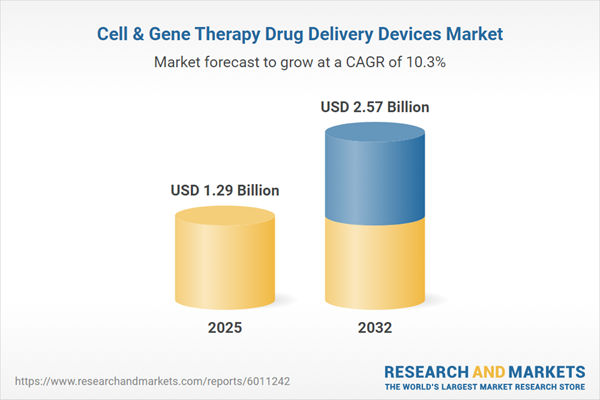Speak directly to the analyst to clarify any post sales queries you may have.
Cell and gene therapy drug delivery devices are elevating precision in advanced therapeutics, offering pivotal solutions that meet shifting regulatory and operational priorities. Senior decision-makers gain essential guidance to navigate innovation, foster compliance, and enable streamlined care models in this rapidly evolving arena.
Market Snapshot: Cell and Gene Therapy Drug Delivery Devices Market
In 2024, the global cell and gene therapy drug delivery devices market reached a valuation of USD 1.17 billion, propelled by regulatory momentum and growing clinical workflow integration. Projections indicate continued expansion, with an estimated size of USD 1.29 billion in 2025 and a forecasted annual growth rate of 10.29 percent through 2032. The market’s trajectory benefits from advancements in device technology, expanded use of personalized therapies, and increasing digital connectivity in treatment delivery. These trends are extending patient access and shaping new global standards of care as technology adoption and regulation accelerate sector transformation.Scope & Segmentation: Cell and Gene Therapy Drug Delivery Devices Market
- Device Types: Autoinjectors, implantable pumps, infusion pumps, microfluidic devices, needle-free injectors, pre-filled syringes, and conventional syringes foster reliability, safety, and efficiency for a range of therapeutic applications.
- End Users: Clinics, hospitals, specialty centers, and homecare organizations depend on flexible drug delivery devices to streamline treatment in both facility-based and at-home care environments.
- Product Types: Reusable and single-use systems meet needs in infection control, patient safety, and operational cost management, suiting diverse care strategies.
- Therapy Types: Delivery solutions address advanced modalities, including CAR-T cell therapy, dendritic cell therapy, stem cell treatments, and gene therapies, each with unique handling and safety requirements.
- Distribution Channels: Hospital pharmacies, online channels, mail-order services, major retail chains, and independent outlets ensure broad market accessibility and efficient device distribution to providers and patients alike.
- Geographic Coverage: Market reach spans the Americas, Europe, Middle East, Africa, and Asia-Pacific, with a spotlight on key countries such as the United States, Germany, Japan, China, Brazil, and India. Each region features distinct regulatory frameworks, infrastructure capabilities, and technology adoption rates, shaping the competitive landscape.
- Key Companies Profiled: Major industry players, including Becton, Dickinson and Company, Terumo Corporation, B. Braun Melsungen AG, ICU Medical, Inc., West Pharmaceutical Services, Inc., Gerresheimer AG, Ypsomed Holding AG, Catalent, Inc., Fresenius SE & Co. KGaA, and MaxCyte, Inc., are progressively advancing device technology, setting quality benchmarks, and maintaining regulatory compliance.
Key Takeaways: Strategic Insights for Senior Leaders
- Customizing device design to specific therapy and user needs drives operational efficiencies and supports consistent patient engagement across care models.
- Deployment of advanced microfluidic and integrated device solutions supports real-time data exchange, enhancing collaboration among multidisciplinary care teams and streamlining management workflows.
- Changing regulatory landscapes contribute to optimized device approval processes, allowing healthcare organizations and manufacturers to adapt swiftly while sustaining compliance.
- Advancements in remote monitoring extend the reach of drug delivery devices, enabling effective patient tracking and supporting more scalable, home-based therapeutic protocols.
- The focus on decentralized treatment highlights the importance of intuitive, widely accessible technologies to address care disparities and expand market penetration.
- Enhanced cooperation among device manufacturers, therapy developers, and logistics partners strengthens sourcing efficiency and responsiveness to market and regulatory changes.
Tariff Impact: 2025 United States Adjustments
Recent United States tariff revisions are prompting manufacturers to reassess sourcing and operational frameworks. Emphasis on regional and domestic manufacturing supports stronger partnerships with therapy developers, improves supply chain resilience, and minimizes risk from international disruptions affecting advanced drug delivery devices.
Methodology & Data Sources
This analysis merges comprehensive interviews with senior industry leaders and clinicians, peer-reviewed studies, proprietary surveys, and current market data. The resulting synthesis ensures up-to-date, actionable insight tailored to both clinical and home-care scenarios in the cell and gene therapy drug delivery devices market.
Why This Report Matters
- Equips executives with strategic intelligence for procurement, investment, and growth decision-making in the evolving field of cell and gene therapy drug delivery devices.
- Enables organizations to assess technology strategies in alignment with specific regulatory, operational, and market requirements across global regions.
- Provides essential benchmarks and scenario analysis to support expansion and seamless adoption of advanced therapies in both established and emerging healthcare markets.
Conclusion
Advancing leadership in the cell and gene therapy drug delivery devices market depends on proactive innovation, responsiveness to regulatory shifts, and building alliances that drive continuing sector progress and value.
Additional Product Information:
- Purchase of this report includes 1 year online access with quarterly updates.
- This report can be updated on request. Please contact our Customer Experience team using the Ask a Question widget on our website.
Table of Contents
3. Executive Summary
4. Market Overview
7. Cumulative Impact of Artificial Intelligence 2025
Companies Mentioned
The companies profiled in this Cell & Gene Therapy Drug Delivery Devices market report include:- Becton, Dickinson and Company
- Terumo Corporation
- B. Braun Melsungen AG
- ICU Medical, Inc.
- West Pharmaceutical Services, Inc.
- Gerresheimer AG
- Ypsomed Holding AG
- Catalent, Inc.
- Fresenius SE & Co. KGaA
- MaxCyte, Inc.
Table Information
| Report Attribute | Details |
|---|---|
| No. of Pages | 189 |
| Published | November 2025 |
| Forecast Period | 2025 - 2032 |
| Estimated Market Value ( USD | $ 1.29 Billion |
| Forecasted Market Value ( USD | $ 2.57 Billion |
| Compound Annual Growth Rate | 10.2% |
| Regions Covered | Global |
| No. of Companies Mentioned | 11 |









